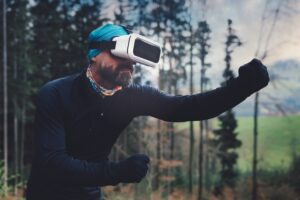Games can include components that can boost student engagement and maintain motivation, such as interaction, feedback, problem-solving, competition, story, and enjoyable learning environments. This article explains the distinction between gamification and game-based learning, the pedagogical benefits these two approaches can have on classroom education, and the kinds of game components that are suitable for both in-person and online learning.

Gamification is the process of using game elements in a non-game context. It has many advantages over traditional learning approaches, including:
- Increasing learner motivation levels
- Improving knowledge retention
- Better learner engagement through social mechanisms like badges, points, or leaderboards
Both gamification and game-based learning encourage engagement and ongoing motivation in learning, which is where they have a lot in common. Gamification and game-based learning, however, can also be separated helpfully.
Gamification is the incorporation of game components such as leaderboards, badges, point systems, and other game-related elements into “traditional” learning activities in order to boost motivation and engagement. A badge system, for instance, could be used to gamify an online discussion board for a physics course. For instance, students might receive a “Ptolemy” badge after making 10 posts, a “Galileo” badge after making 20 posts, a “Kepler” badge after making 30 posts, an “Einstein” badge after making 40 posts, and so on. Students can view the online badges that their peers have acquired to foster a sense of camaraderie or competitiveness in the best-gamified learning settings.
Contrarily, game-based learning entails creating learning activities that incorporate game elements and principles into the learning activities itself. For instance, in an economics course, students can compete in a computerized stock-trading competition; in a course on politics, they might role-play as they participate in pretend talks over a labor dispute.
In short, game-based learning creates inherently game-like learning activities, whereas gamification adds game components or a game framework to existing learning activities.
In gaming, the goal is to use a game to achieve a skill or learning objective. The game is embedded into the course. Think of it as a design element similar to a graphic, table, or video. You play the game, and you learn a skill.
Gamification is a pedagogical system. The entire course is built around the concept of playing a game, but not playing a game itself. Essentially, you are making a game out of something that is not. Gamification appeals to the learner’s competitive side, similar to finding coupons, collecting frequent flyer miles, or getting to the next level credit card. Our lives have become gamified, and learning is catching on. Gamification in education refers to the use of game design principles in a learning environment by educators. Usually, the aim is to increase learning engagement.
Given the stark contrasts between, for example, chess, The Sims, and tag, it might be challenging to break the concept of a “game” down into individual game design components. In reality, there is a wide variety of aspects that games can include, and various players are drawn to different elements. Dr. Nick Yee, a researcher, suggested the following method for modeling the components of what drives gamers:
- Action (e.g., objectives) (e.g., objectives)
- Social (e.g., competition) (e.g., competition)
- Mastery (e.g., scoring) (e.g., scoring)
- Achievement (e.g., awards) (e.g., awards)
- Immersion (e.g., roleplaying) (e.g., roleplaying)
- Creativity (e.g., customization) (e.g., customization)
A good example of an educational platform that uses gamification is Duolingo. On this platform, users can practice and play while learning new languages. To keep themselves motivated during the learning process, students can collect points, level up, and compete with others.
Gamification is an excellent tool for assisting people with their learning and inspiring them to work harder. For improved results, leaders can apply gamification to a variety of tasks and objectives that require engagement and motivation. It is a great way of having fun while learning!

Sources:
- https://uwaterloo.ca/centre-for-teaching-excellence/teaching-resources/teaching-tips/educational-technologies/all/gamification-and-game-based-learning
- https://elearningindustry.com/gamification-for-learning-strategies-and-examples
- https://ttcinnovations.com/gaming-vs-gamification-is-there-a-difference/
- https://www.hmhco.com/blog/what-is-gamification-in-education
Hits: 37
